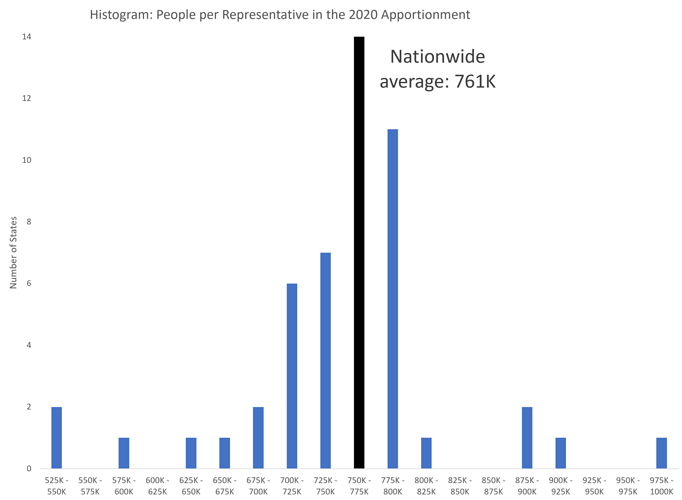Yes, most every state is highly gerrymandered, and we can assume that each new seat will go to the party currently in control of that state’s state house.
Re gerrymandering: One of the downsides to creating majority minority districts is the correlation between party support and race leads to more polarized (by party) districts.
To be fair, while they are going to continue to be over-represented in the House, they will continue to not the most over-represented state in the House, and actually drop into third place on that score.
States by population per House seat (2020):
Montana: 542,704
Rhode Island: 549,082
Wyoming: 577,719
States by population per House seat (2010):
Rhode Island: 526,284
Wyoming: 563,626
Nebraska: 608,780
BTW, my preferred solution is to increase Congress by ~50%.
Add a Senator from each state in whichever class they’re currently missing. Get rid of the phenomenon where more red states or blue states are defending seats in any given election. Every state has a Senate election every two years.
Increase the House from 435 to 650. Keep the one Rep minimum.
800 electoral votes. 401 needed to win.
Yup. Make each house seat worth ~500k people. House size would increase to 660 for the next 10 years.
The districting info is not promised til September 30… which is a bit long, I think.
I am really looking forward to seeing what New York does with its loss of one seat.
Most likely. The legislature is currently in session. Ordinarily they would have attempted to complete redistricting by the end of May (when session ends) but given the late publication of the census there is likely to be a special session this summer to specifically address redistricting. And while there have been bills filed to make redistricting “more fair” they haven’t gone anywhere and are unlikely to get any traction.
I’m not sure what you are trying to solve.
We will always have some states with less population per district and others with more (as long as we stick with integral number of reps and one vote per rep).
It looks like 435 reps means that
Delaware will have 991k people per rep, and
Montana will have 543k people per rep.
If we increase the House to 650, Alaska will have one rep and ND will have two. This means that
Alaska would have 736k people per rep, and
ND would have 390k people per rep.
The numbers are different, but I don’t see that they are materially better.
I think you’re assuming that all three senators from each state would be of the same party. If state delegations are split, we would still have the “more red/blue incumbents up for re-election this year” phenomenon.
I think this is slightly more than a nit-pick. Politically, we only care about “defending seats” when the seats are from competitive states. Seats in deep red or deep blue states don’t really get into the political calculation.
But, it’s the competitive states that are most likely to have split delegations, and hence contribute to variations in “defending” seats.
Not only that, but where would the indexing rabbit hole stop? We’d have different numbers of reps every census cycle. I don’t like that solution either. I think the way we have it now is fine.
The problem -I’m- trying to solve is way too many people per rep (it’s about 760K per rep now), and the dispersion for the smallest states is pretty bad.
Let me give you the histogram of people per representative after the 2020 apportionment:
If there were more reps to allot, we wouldn’t have such a huge disparity in these ratios.
Also, I think some states are too big, and need to be split up, but that’s a different issue.
I think barring Congressional action, given the political climate in the country and the improvements in political mapping algorithms, states where one party controls the state government and where there aren’t laws prohibiting the practice will see gerrymandering to a greater degree in the past.
There’s a pretty good chance that Texas will send at least two more R’s to Congress in 2023.
We used to have more reps each census cycle, until they froze the number of reps.
I agree with Campbell that we ought to expand the house, so representatives can better represent their citizens. I see no benefit to expanding the Senate.
The challenge I see is that an enlarged legislature creates a potential problem because of the “too many cooks” phenomenon.
My pipe dream is to at least partially do away with the concept of geography-based representation…but I’m weird, and the Constitutional constraints on representation being allocated among the states sharply limit the possibility.
Dammit, no no no no no no… now I have to go watch it…
Seems like an administrative nightmare. I don’t have time to do the math right now to see how big of a problem this really is (maybe late next week), but those small states are so small in terms of votes in the House, that I’m skeptical that it matters.
I think the real problem is the physical size of the building. And remember they have to pack in 100 senators for special joint Congress stuff, plus some Supreme Court Justices.
No they don’t. It may be tradition, but it isn’t a requirement.
Increasing the number of politicians doesn’t seem like a better thing to me. I think you’re fooling yourself if you think you would get better “representation” with any of these changes. Politicians represent those who donate to their election campaigns. More donations = more representation. It’s really quite simple. If we had 330M representative, then you might get the representation you truly want - otherwise, it’s just not going to happen.
